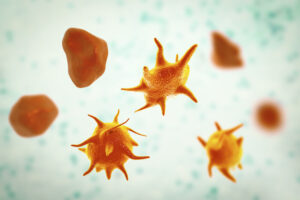In the United States, over 90% of platelets are collected by plateletpheresis, and donors may give platelets up to 24 times annually. Recent studies, however, have observed that frequent platelet donors may develop lymphopenia. To gain a better understanding of risk factors for T-cell lymphopenia in frequent platelet donors (who have donated platelets at least 20 times within the past 12 months), researchers compared CD4+ T-cell counts in frequent platelet donors who donated exclusively using the Trima instrument (n=133) or the Amicus instrument (n=77). Whole blood donors matched by age and sex were used as controls (n=126). At enrollment, 9.9% and 4.4% of frequent Trima (LRS+) and Amicus platelet donors had CD4+ T-cell counts <200 cells/µL, respectively, compared to no whole blood donors. Older age, an increased number of donations, and collection using the Trima instrument were identified as risk factors for developing T-cell lymphopenia. However, the risk of developing lymphopenia may be decreased by using a plasma rinseback procedure with the Trima instrument. While the clinical significance of lymphopenia from platelet donations is unclear, platelet donors should be made aware of this risk.
Reference:

